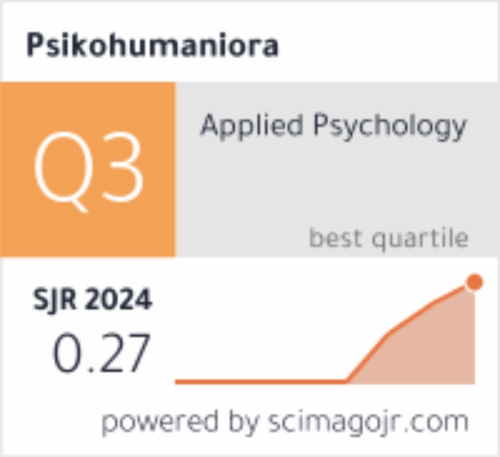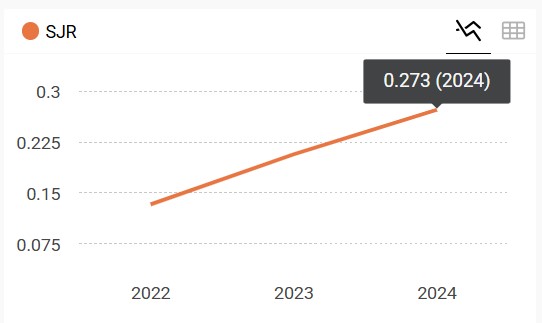“Making Generation Y Stay”: The Mediating Role of Organizational Commitment
DOI:
https://doi.org/10.21580/pjpp.v3i2.2513Keywords:
Generation Y, organizational commitment, perceived organizational support, turnover intention, urbanAbstract
Job turnover in Generation Y has become a common phenomenon in industry in large cities. They tend to believe that it is not difficult to leave their jobs and not important to immediately settle in an organization. The study aimed to understand the mediating role of organizational commitment (OC) between perceived organizational support (POS) and turnover intention (TO). A purposive sampling technique was used in this study with 284 generation Y employees living in large cities (19-37 years old) as participants. There were three questionnaires used in this study namely Turnover Intention Scale, Organizational Commitment Scale and Survey of Perceived Organizational Support. The investigation discovered that POS positively affected OC and negatively TO. Employing mediation analysis showed that OC was a significant mediator from the relationship of POS and TO. The findings of this research provide organizations with information about how to effectively manage and retain Generation Y employees through POS and OC.
Downloads
References
Akgunduz, Y., & Sanli, S. C. (2017). The effect of employee advocacy and perceived organizational support on job embeddedness and turnover intention in hotels. Journal of Hospitality and Tourism Management, 31, 118–125. https://doi.org/10.1016/j.jhtm.2016.12.002
Ali, H., & Purwandi, L. (2016). Indonesia 2020: The urban middle-class millennials. Jakarta: Alvara Research Center.
Alkahtani, A. H. (2015). Investigating factors that influence employees’ turnover intention: A review of existing empirical works. International Journal of Business and Management, 10(12), 152. https://doi.org/10.5539/ijbm.v10n12p152
Allen, D. G., Shore, L. M., & Griffeth, R. W. (2003). The role of perceived organizational support and supportive human resource practices in the turnover process. Journal of Management, 29(1), 99–118.
Aruna, M., & Anitha, J. (2015). Employee retention enablers: Generation Y employees. SCMS Journal of Indian Management, 12(3), 94–103.
Bartlett, K. R. (2001). The relationship between training and organizational commitment: A study in the health care field. Human Resource Development Quarterly, 12(4), 335–352.
Catano, V. M., & Hines, H. M. (2016). The influence of corporate social responsibility, psychologically healthy workplaces, and individual values in attracting millennial job applicants. Canadian Journal of Behavioural Science / Revue Canadienne Des Sciences Du Comportement, 48(2), 142–154. https://doi.org/10.1037/cbs0000036
Chang, W.-J. A., Wang, Y.-S., & Huang, T.-C. (2013). Work design-related antecedents of turnover intention: A aultilevel approach. Human Resource Management, 52(1), 1–26. https://doi.org/10.1002/hrm.21515
Eisenberger, R., Armeli, S., Rexwinkel, B., Lynch, P. D., & Rhoades, L. (2001). Reciprocation of perceived organizational support. Journal of Applied Psychology, 86(1), 42–51. https://doi.org/ 10.1037/0021-9010.86.1.42
Eisenberger, R., Huntington, R., Hutchison, S., & Sowa, D. (1986). Perceived organizational support. Journal of Applied Psychology, 71(3), 500–507.
Fadzilah, W., Yusoff, W., Queiri, A., Zakaria, S., & Hisham, R. R. I. R. (2013). Generation-Y turnover intention. 2nd International Conference on Management, Economics and Finance, (October), 429–439. https://doi.org/10.13140/2.1.1577.6001
Forastero, A., Sjabadhyni, B., & Mustika, M. D. (2018). What millennials want: How to optimize their work. Psikohumaniora: Jurnal Penelitian Psikologi, 3(1), 1–16. https://doi.org/10.21580/pjpp.v3i1.2489
Gao, H., Lu, M., & Sato, H. (2015). Inclusive urban employment: How does city scale affect job opportunities for different people? Asian Economic Papers, 14(2), 98–128. https://doi.org/10.1162/ASEP_a_00352
Gravetter, F. J., & Forzano, L.-A. B. (2012). Research methods for the behavioral sciences (4th ed.). Belmont, CA: Wadsworth Cengage Learning.
Hayes, A. F. (2018). Introduction to mediation, moderation, and conditional process analysis: A regression-based approach (2nd ed.). New York: Guilford Publications.
Hussain, T., & Asif, S. (2012). Is employees’ turnover intention driven by organizational commitment and perceived organizational support? Journal of Quality and Technology Management, 8(2), 1–10.
Iqbal, S., Ehsan, S., Rizwan, M., & Noreen, M. (2014). The impact of organizational commitment, job satisfaction, job stress and leadership support on turnover intention in educational institutes. International Journal of Human Resource Studies, 4(2), 181–195. https://doi.org/10.5296/ ijhrs.v4i2.5906
Islam, T., Aamir, M., Khan, S. R., & Ahmad, U. N. U. (2013). Organizational learning culture, social exchange relations and multifoci citizenship behaviors: A literature survey approach. World Journal of Management and Behavioral Studies, 1(1), 6–13. https://doi.org/10.5829/ idosi.wjmbs.2013.1.1.1102
Islam, T., Khan, S. ur R., Ahmad, U. N. bt. U., Ali, G., Ahmed, I., & Bowra, Z. A. (2013). Turnover intentions: The influence of perceived organizational support and organizational commitment. In Procedia - Social and Behavioral Sciences (13th International Educational Technology Conference) (Vol. 103, pp. 1238–1242). https://doi.org/10.1016/j.sbspro.2013.10.452
Kalidass, A., & Bahron, A. (2015). The relationship between perceived supervisor support, perceived organizational support, organizational commitment and employee turnover intention. International Journal of Business Administration, 6(5), 82–89. https://doi.org/10.5430/ ijba.v6n5p82
Kralj, A. L., & Solnet, D. J. (2011). The influence of perceived organizational support on engagement: A cross-generational investigation in the hospitality industry. 2011 International CHRIE Conference-Refereed Track. 9, 1–9.
Lee, K., Allen, N. J., Meyer, J. P., & Rhee, K.-Y. (2001). The three-component model of organisational commitment: An application to South Korea. Applied Psychology, 50(4), 596–614. https://doi.org/10.1111/1464-0597.00075
Meyer, J. P., & Alien, N. J. (1991). A three-component conceptualization of organizational commitment. Human Resource Management Review, 1(1), 61–89. https://doi.org/10.1016/1053-4822(91)90011-Z
Meyer, J. P., Allen, N. J., & Smith, C. A. (1993). Commitment to organizations and occupations: Extention and test of a three-part conceptualization. Journal of Applied Psychology, 78(4), 538–551.
Mobley, W. H., Griffeth, R. W., Hand, H. H., & Meglino, B. M. (1979). Review and conceptual analysis of the employee turnover process. Psychological Bulletin, 86(3), 493–522. https://doi.org/10.1037/0033-2909.86.3.493
Mobley, W. H., Horner, S. O., & Hollingsworth, A. T. (1978). An evaluation of precursors of hospital employee turnover. Journal of Applied Psychology, 63(4), 408–414. https://doi.org/10.1037/0021-9010.63.4.408
Muneer, S., Muhammad Javed Iqbal, S., ur Rehman Khan, S., & Sang Long, C. (2014). An incorporated structure of perceived organizational support, knowledge-sharing behavior, organizational trust and organizational commitment: A strategic knowledge management approach. Pakistan Journal of Commerce and Social Sciences, 8(1), 42–57. https:www.jespk.net/publications.php
Mustari, A. S., Sulistyowati, R., Lanny, T., & Nugroho, S. W. (2015). Statistik pemuda Indonesia: Hasil survei sosial ekonomi Nasional. Jakarta. Retrieved from https://media.neliti.com/media/ publications/48324-ID-statistik-pemuda-indonesia-2015.pdf
Myers, K. K., & Sadaghiani, K. (2010). Millennials in the workplace: A communication perspective on millennials’ organizational relationships and performance. Journal of Business and Psychology, 25(2), 225–238. https://doi.org/10.1007/s10869-010-9172-7
Ng, E. S. W., Schweitzer, L., & Lyons, S. T. (2010). New generation, great expectations: A field study of the millennial generation. Journal of Business and Psychology, 25(2), 281–292. https://doi.org/10.1007/s10869-010-9159-4
Nielsen: An Uncommon Sense of the Consumer. (2015). Global generational lifestyles: How we live, eat, play, work and save our futures. Retrieved from https://www.nielsen.com/content/dam/ nielsenglobal/eu/docs/pdf/Global Generational Lifestyles Report FINAL.PDF
Park, I.-J., & Jung, H. (2015). Relationships among future time perspective, career and organizational commitment, occupational self-efficacy, and turnover intention. Social Behavior and Personality, 43(9), 1547–1562. https://doi.org/10.2224/sbp.2015.43.9.1547
Podsakoff, P. M., MacKenzie, S. B., Lee, J. Y., & Podsakoff, N. P. (2003). Common method biases in behavioral research: A critical review of the literature and recommended remedies. Journal of Applied Psychology, 88(5), 879–903. https://doi.org/10.1037/0021-9010.88.5.879
Rhoades, L., & Eisenberger, R. (2002). Perceived organizational support: A review of the literature. Journal of Applied Psychology, 87(4), 698–714. https://doi.org/10.1037/0021-9010.87.4.698
Robyn, A., & Du Preez, R. (2013). Intention to quit amongst Generation Y academics in higher education. SA Journal of Industrial Psychology, 39(1), 1–14. https://doi.org/10.4102/sajip.v39i1.1106
Saxena, P., & Jain, R. (2012). Managing career aspirations of generation Y at work place. International Journal of Advanced Research in Computer Science and Software Engineering, 2(7), 114–118. https://doi.org/10.1006/taap.1999.8820
Shore, L. M. F., & Wayne, S. J. (1993). Commitment and employee behavior: Comparison of affective commitment and continuance commitment with perceived organizational support. Journal of Applied Psychology, 78(5), 774–780. https://doi.org/10.1037/0021-9010.78.5.774
Solnet, D., & Hood, A. (2008). Generation Y as hospitality employees: Framing a research agenda. Journal of Hospitality and Tourism Management, 15(1), 59–68. https://doi.org/10.1375/jhtm.15.59
Stanimir, A. (2015). Generation Y – characteristics of attitudes on labour market. Mediterranean Journal of Social Sciences, 6(2), 22–28. https://doi.org/10.5901/mjss.2015.v6n2s5p22
Steers, R. M. (1977). Antecedents and outcomes of organizational commitment. Administrative Science Quarterly, 22(1), 46. https://doi.org/10.2307/2391745
Tett, R. P., & Meyer, J. P. (1993). Job satisfaction, organizational commitment, turnover intention, and turnover: Path analyses based on meta‐analytic findings. Personnel Psychology, 46(2), 259–293. https://doi.org/10.1111/j.1744-6570.1993.tb00874.x
Tumwesigye, G. (2010). The relationship between perceived organisational support and turnover intentions in a developing country : The mediating role of organisational commitment. African Journal of Business Management, 4(6), 942–952.
Tuzun, I. K., & Kalemci, R. A. (2012). Organizational and supervisory support in relation to employee turnover intentions. Journal of Managerial Psychology, 27(5), 518–534. https://doi.org/ 10.1108/02683941211235418
Wong, Y. T. E., Wong, Y. W., & Woon, Y. (2015). An integrative model of turnover intention: Antecedents and their effects on employee performance in Chinese joint ventures. Journal of Chinese Human Resource Management, 6(1), 71–90. https://doi.org/10.1108/JCHRM-06-2014-0015
Yin-Fah, B. C., Foon, Y. S., Chee-Leong, L., & Osman, S. (2010). An exploratory study on turnover intention among private sector employees. International Journal of Business and Management, 5(8), 57–64. https://doi.org/10.5539/ijbm.v5n8p57
Downloads
Published
How to Cite
Issue
Section
License
The copyright of the accepted article shall be assigned to the publisher of the journal. The intended copyright includes the right to publish the article in various forms (including reprints). The journal maintains the publishing rights to published articles.
In line with the license, authors and any users (readers and other researchers) are allowed to share and adapt the material only for non-commercial purposes. In addition, the material must be given appropriate credit, provided with a link to the license, and indicated if changes were made. If authors remix, transform, or build upon the material, authors must distribute their contributions under the same license as the original.




